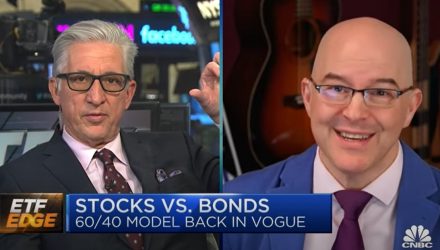On today’s edition of ETF Edge with Bob Pisani, VettaFi financial futurist Dave Nadig and F/M Investment’s CIO Alexis Morris discussed the return of bonds.
The 60/40 portfolio, declared dead in 2022, has roared back with a vengeance in 2023. Two-year treasuries are yielding roughly 5% and single-stock bond treasury ETFs are seeing huge inflows, according to Pisani. Morris provided context for how bond ETFs work, explaining how funds like the US Treasury 2 Year Note ETF (UTWO) hold “on the run” two-year notes. Morris explained that every month a new note is issued, and the previous month’s note is sold off and put into the new note.
“I think they absolutely are becoming a significant competitor to stocks, to frankly any risk asset,” Nadig said, pointing out that six-month treasury bills are currently the highest yielding part of the curve. “That’s nuts, that kind of inversion, first of all, is something we haven’t seen in a long time.” Though concerns remain about the broader health of the markets, in the short term, bonds are offering some fast and punchy returns to investors.
When asked what the right amount of allocation to bonds is, Morris said, “there should be a healthy allocation to bonds. It shouldn’t be just treasuries, there should be corporates, there should be a well-diversified basket of it.”
Despite the booming success of short-term bonds, long-term bonds haven’t sparked the same kind of interest. Nadig isn’t surprised there is wariness around the longer end of the curve, adding “we know interest rates are going to keep going up.” According to Nadig, an inverted yield curve where the short end pays out more than the long end is going to be fleeting. “I think that lasts for maybe six, twelve months tops.”
Pisani shared that these inflows into bonds aren’t an across-the-board thing and that some high-yield bonds are even seeing outflows. Morris said he wouldn’t count out long bonds in the long run. “The U.S. treasury remains one of the most liquid securities ever,” he said.
Why Bonds Belong in ETFs
Given that bonds can be purchased online, Pisani asked Morris what the advantages of having them in an ETF are. Morris noted that it’s quite challenging to purchase a bond and can be confusing. An ETF makes the process significantly easier.
“It’s not the case that you can just click a button, get the exposure of the headlining rate that you are reading in the Wall Street Journal or seeing on CNBC,” Nadig concurred. He noted that due to the challenges of buying a bond directly and the potential for user error, a 15 to 20 basis point ETF that could even end up being cheaper. Nadig added, “if I was trying to get an allocation for a two-year, I would not be going to TreasuryDirect.”
Asked what the narrative is around bonds, Nadig shared, “I think the narrative is, I’d come back to the issue of diversification.”
For more news, information, and analysis, visit the Fixed Income Channel.

